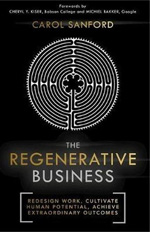Where should innovation begin in organizations – first at workplace and people or with new products? Author Carol Sanford tries to answer this billion dollar question in her new book The Regenerative Business – Redesign Work, Cultivate Human Potential, Achieve Extraordinary Outcomes, published by Nicholas Brealey Publishing, 2017.
She compellingly argues and, even demonstrates with experience of doing it in 100 organizations over 30 years, that those who started with workplace redesign and with people’s development as the central piece, innovative products and services emerge on their own resulting in high profitability and longevity.
The book is highly relevant today because of massive confusion among business leaders about how to stay relevant and profitable at the same time. Deep disruptions have become the order of the day because of rapid technological changes and the unusual work culture of the millennial generation.
Carol says her aim is to “grow a higher level of discernment and creative thinking into the practice of work design.” Her goal is to help build organizations with self-managing workers, where everyone is a “co-creator of every aspect of management – from strategy to hiring to pay system to customer service.”
This is a book from someone who has had big successes – one by helping create Google Foodlabs and the other at Consolidated Diesel Company, a joint venture between Cummins Engine and J.I.Case.
This book could herald a paradigm shift in how companies are managed – “there is more to the idea of enlightened disruption than just bringing breakthrough products to market.” Carol offers a roadmap and tools of how this can be done. The chapter headlines indicate how deep this book goes into what it is set out to do.
Carol brilliantly shows how most of the questions that are top of mind of managers, CEOs and academia become irrelevant if they apply the principles of ‘regenerative business.’ This is because it addresses all of them simultaneously, “as the byproduct of creating an innovative company.” She chides the best-practices industry for undermining an organization’s potential.
It’s difficult to find holes in her book except wonder if it adequately addresses the very tough challenge businesses face today of managing the millennial workforce, the strange factors that drive today’s start-ups, the near catastrophe that automation is creating, the redundancy of white collar, the emergence of the ‘gig economy’ (where a big chunk of work is done by freelancers).
It may be a good idea to supplement reading Carol’s book with Peter Thiel’s Zero to One – Notes on Startups, or How to Build the Future’ and Jagdish Sheth’s Firms of Endearment: How World – Class Companies Profit from Passion and Purpose (2014).
Carol Sanford is a powerful force for change and her five books show how. Her published work include – Responsible Entrepreneur – Four game-changing archetypes for founders, leaders, and impact investors; The Responsible Business: Reimagining Sustainability and Success; Getting Beyond Better: How Social Entrepreneurship Works. www.carolsanford.com.










